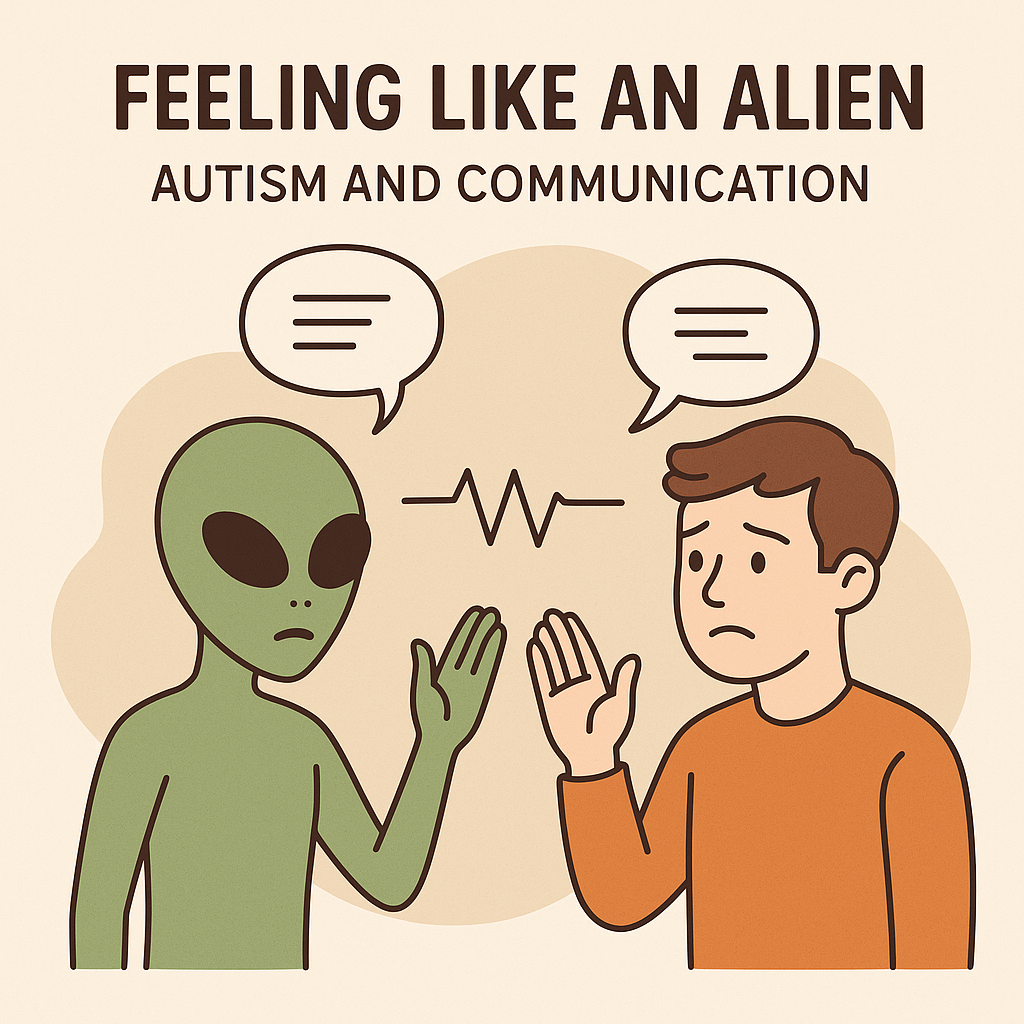“Feeling Like an Alien”: Finding Understanding Across Different Worlds

A young person I support said something to me recently that really stayed with me.
“Having autism makes you feel like an alien.”
It was a simple but powerful statement, one that spoke volumes about how isolating the world can sometimes feel for those who experience it differently.
As we explored the feeling together, what sat at the heart of that comment was communication, or more precisely, miscommunication. The moments when words, gestures, and tones between neurodivergent and neurotypical people seem to pass each other without truly connecting. It’s not that one person isn’t trying to understand; it’s that they’re often speaking slightly different emotional languages.
When Messages Miss Each Other
In our conversation, we reflected on what it feels like when those messages miss their target. Imagine two people trying to talk through walkie-talkies tuned to different channels. Each is speaking clearly, but the signals never quite line up. Both end up feeling misunderstood – and, over time, that can grow into a deep sense of loneliness or frustration.
Psychologist Damian Milton described this beautifully in what’s known as the Double Empathy Problem (2012). He explains that the difficulty isn’t a lack of empathy on either side, it’s a difference in how empathy is communicated and received. Both neurodivergent and neurotypical people can find it hard to interpret each other’s cues. It’s not a one-way issue; it’s a shared one.
From a coaching/theraputic point of view, this shifts the focus from “fixing” someone’s communication style to understanding and bridging between two equally valid ways of experiencing the world.
Different Roads, Same Destination
I often imagine it like two roads running side by side. One follows clear, predictable signposts; the other winds in its own unique rhythm. Neither is the “right” way to travel, they’re just designed differently.
When the people on each road try to meet, they might wave, flash their lights, or honk, each with good intention, but the signals get misread. One person thinks the other is saying hello; the other thinks they’re warning of danger.
No wonder so many young people I work with describe feeling as though they’re on the wrong planet. The truth is, they’re not. They’re simply living in a world that was built with one type of communication in mind.
“If Everyone Had Autism, I’d Feel Normal”
My client then said, “It would be good if everyone had autism. Then I’d feel normal.”
We smiled at that together, because underneath the humour was a deep truth.
What they were really expressing was a longing for belonging, for a world that meets them where they are, rather than asking them to continually adapt. It reminded me that “normal” is just a word society uses to describe the majority, not a marker of worth or capability.
If everyone had autism, the rules of communication would look different, perhaps more direct, more honest, less filled with grey areas. But since we live in a mixed world, our work becomes about translation, not transformation.
Creating Shared Understanding
So how do we bridge those two roads?
How can someone who feels “alien” start to feel a little more at home on Earth?
Here are a few reflections I often return to, both as a coach, therapist and a human being:
- Slow the Conversation
Taking a moment to check, clarify, or rephrase gives both people time to align their understanding. A simple “Can I just make sure I understood you right?” can transform a moment of disconnection into one of care. - Be Curious Instead of Certain
Instead of assuming what someone means, approach with curiosity. This opens the door for exploration rather than correction. - Use Shared Anchors
Written notes, visuals, or clear examples can act as bridges when words alone feel slippery. - Recognise Emotional Truths
When someone says, “I feel like an alien,” what they’re really saying is, “I feel unseen.” Meeting that feeling with empathy, not logic, helps them feel grounded again. - Model Inclusion in Action
As professionals, parents, or peers, the more we normalise difference, in language, behaviour, and ways of thinking, the more we redefine what “normal” actually means.
We’re All Learning Each Other’s Languages
The longer I do this work, the more I believe we’re all just trying to learn each other’s languages. Some people speak through tone, others through movement, music, or silence. None of these are wrong, they’re simply different dialects of being human.
Maybe, then, the goal isn’t for my client to stop feeling like an alien, but for the rest of us to become better space travellers, willing to visit, learn, and listen to new worlds without trying to change them.
Because when we start to meet each other halfway, communication stops being about fixing misunderstandings and starts becoming about connection.
And that, I think, is when the alien finally feels at home.
References
- Milton, D. (2012). On the Ontological Status of Autism: The Double Empathy Problem. Disability & Society.
- Premack, D., & Woodruff, G. (1978). Does the Chimpanzee Have a Theory of Mind? Behavioral and Brain Sciences.